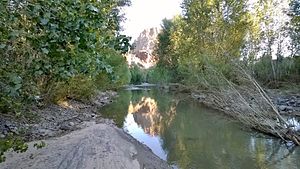| Big Sandy River | |
|---|---|
 Big Sandy River in the Arrastra Mountain Wilderness | |
| Location | |
| Country | United States |
| State | Arizona |
| County | Mohave, La Paz |
| Physical characteristics | |
| Source | Between Hualapai and Aquarius ranges |
| • location | East of U.S. Route 93 near Hualapai Indian Reservation, Mohave County |
| • coordinates | 34°55′21″N 113°37′37″W / 34.92250°N 113.62694°W[1] |
| • elevation | 2,435 ft (742 m)[2] |
| Mouth | Bill Williams River |
• location | Alamo Lake State Park, La Paz County |
• coordinates | 34°18′38″N 113°31′36″W / 34.31056°N 113.52667°W[1] |
• elevation | 1,237 ft (377 m)[1] |
| Length | 55.7 mi (89.6 km)[3] |
| Basin size | 1,988 sq mi (5,150 km2)[4] |
| Discharge | |
| • minimum | 0 cu ft/s (0 m3/s) |
The Big Sandy River is both an intermittent and perennial stream in Mohave and La Paz counties in northwestern Arizona in the United States. It begins where Cottonwood Wash and Trout Creek converge in the Hualapai Indian Reservation east of U.S. Route 93 then flows past Wikieup south of Kingman. The Big Sandy River then passes the Signal Ghost Town Site, meanders through the Arrastra Mountain Wilderness, and joins the Santa Maria River in Southern Mohave County to form the Bill Williams River. The Bill Williams River then empties into Alamo Lake State Park. The Big Sandy River is 55.7 miles (89.6 km) long.[3]
The Big Sandy drainage basin covers approximately 2,000 square miles (5,200 km2) in Mohave, La Paz, and Yavapai counties.[4] The Hualapai Mountains are west of the river, and the Aquarius and Mohon Mountains lie to the east and southeast, the Juniper Mountains further east, and the Peacock Mountains and Cottonwood Mountains to the north. Hualapai Peak at 8,417 feet (2,566 m) is the highest point in the basin.[4] The river flows through the Arrastra Mountain Wilderness.
- ^ a b c "Big Sandy River". Geographic Names Information System. United States Geological Survey. February 8, 1980. Retrieved March 28, 2013.
- ^ Source elevation derived from Google Earth search using GNIS source coordinates.
- ^ a b "The National Map". U.S. Geological Survey. Archived from the original on March 29, 2012. Retrieved March 7, 2011.
- ^ a b c "Geography of the Big Sandy Basin". Arizona Department of Water Resources. December 28, 2012. Retrieved March 28, 2013.
